While we were thoroughly covering every shout and tear of Columbia in-person housing selection, Barnard students were learning to use a new, entirely online selection system run through the StarRez portal. This system caused an uproar among rising seniors and faced a barrage of questions when it was announced in February, but how did it actually play out for Barnard students? EIC Betsy Ladyzhets took an in-depth look at the new system, backed up by the newly available data.
On February 10, 2018, the Barnard Residential Life & Housing office sent out an email to the Barnard student body announcing a new housing lottery system. Rather than an individually-based, in-person selection process, Barnard upperclassmen would pick their housing for the next year based on conglomerate group numbers in an entirely online system.
This new system immediately became a cause for concern, particularly among rising seniors who felt as though they had been cheated out of their chance to secure Barnard’s best suites. But how much did this new system actually affect students’ choices of rooms? What can be learned from this year’s selection process to improve future rounds of housing selection? In order to answer these questions, I spoke to Mia Lindheimer, BC ’19, the current SGA Representative for Campus Affairs (and a former Bwogger!), who has worked closely in liaising between students and Matt Kingston, Barnard’s Associate Director for Housing Operations, throughout the new process, and also examined the data available from Res Life on where each group in the Barnard lottery picked.
What changed this year?
The primary changes implemented with the new housing system are in how students pick, and when. In the past decade, Barnard’s housing lottery has been more individual; each student would be randomly assigned a lottery number based on their class year, and groups would take the highest number of all the students in that group. This led to stress and competition, Mia said, as students would try to team up with students who had higher numbers, rather than actually forming groups with their friends. This old system also made it easier for groups to split up, leaving students with higher numbers to secure high-demand rooms while their no-longer-suitemates were left with worse lottery numbers.
Another hallmark of the old system was that it took place entirely in person, over the course of about a week in the Brooks lounge. Similarly to Columbia’s in-person selection, groups would go into a room when their numbers were called, pick their housing, sign their contracts, then go back out. Barnard’s in-person selection was touted as more comprehensive than Columbia’s, as all picks and still available rooms were easily viewable in real time on screens in the outer part of the lounge and online (while in the John Jay lounge, Columbia Res Life operated with a bit of a lag, and did not reveal where each lottery number had picked.)
However, Barnard Res Life was not as organized as it seemed, Mia explained. The old housing selection website was entirely coded by Matt Kingston, often suffered from bugs, and did not sync with the rest of MyBarnard. As a result, at the end of each day of in-person selection, Res Life staffers would need to take the screens displaying where each student had picked back to the office in Sulzberger and physically transcribe every single room choice, then re-upload all of this information onto the MyBarnard portal so that it could be accessed by students, as well as Financial Aid, Dining, and other Barnard offices. This process was extremely labor-intensive for Res Life workers, and led to potential for error in transcription.
Because of the technical issues involved in the old system, Res Life has been hoping to switch over to a housing portal developed by tech professionals for several years now. This switch finally happened this year as Barnard teamed up with StarRez, the world’s leading housing portal system. StarRez is used by numerous schools around the country, including Columbia – although Barnard’s system is set up differently from Columbia’s.
Like in Columbia selection, groups now register together and are assigned a joint lottery number. Unlike in Columbia selection, all of housing selection now takes place online. This makes the process less labor-intensive for Res Life workers, keeps the Brooks Lounge free for student studying, and increases convenience for Barnard students, who now only need to take a few minutes out of their busy days to choose their housing rather than spending a stressful half-hour in Brooks. Many of the Barnard students on Bwog agreed that this online selection was a major improvement.
Also different from Columbia’s process and the old system, Barnard students now pick their housing according to group size, not class year. The new system consists of four different lotteries: the 4-, 5-, and 6-person suite lotteries, and the 1/2/3 lottery for individuals, doubles, and small suites. Each day has students of all class years picking, although students of higher class standing still have better lottery numbers and earlier time-slots. It is also notable that these selection days are spread over several weeks: the 4-person lottery took place on Wednesday, March 21, while the 1/2/3 lottery only concluded this past Friday.
Mia explained that the new system of picking by suite numbers was designed because Barnard’s upperclassmen housing options are primarily suites – different from most other schools, where the majority of housing options are corridor-style. Res Life assumed that most students want suites, and that it is easier to build up suites than to break them down – hence scaling up from 4 to 6 rather than down. The spacing out of selection days allows groups time in between lotteries to regroup, rather than the quick-and-dirty action of senior and junior regroup across the street. If, say, a 4-person group failed to get the suite they wanted and decided to drop to the 5-person lottery, they had a full 48 hours to find a person to join up, then another four days to re-prioritize where they wanted to live. Then, if that failed, the group could either scale up again to go into the 6-person lottery, or split for the 1/2/3 lottery.
The new system is certainly a bit confusing with all of these options for regrouping, especially as groups are assigned a new lottery number each time they register for a different lottery. Housing held several info sessions in order to explain all of these changes (most of which, Mia noted, were not particularly well attended.) But overall, the new system has the same goal as the old: enable all students to secure housing with roommates and suitemates of their choice, while prioritizing upperclassmen.
How were this year’s room choices affected?
One significant advantage of an entirely-online system is that data on housing selection are easier to collect. Barnard Res Life has leaned into this advantage, as the office made spreadsheets with all remaining rooms and all lottery picks available to anyone with a barnard.edu email address. This is a huge step up from previous years, when Barnard students mostly had to guess which rooms and suites would go to whom based on past experience and hearsay; students can now access literally every single choice made by every single housing group of the 2018 housing selection process.
Such a wealth publicly available data offers a wealth of possibilities. Namely, the spreadsheet can be used to identify cutoff scores for each room and suite type, map out where students of each class picked, determine how many students dropped from one lottery to the next, and more. I used Excel to do these calculations, resulting in the colorful charts displayed in the gallery below:
- All picks; note that Gua = guaranteed housing list and Can = cancelled
- 6 person lottery results
- 5 person lottery results
- 4 person lottery results
- 1/2/3 lottery results
- Where all the rising seniors will live
- Where all the rising juniors will live
- Where all the rising sophomores will live
But what does this data actually mean? Well, mostly, that the trends in housing selection weren’t too different from previous years. We can’t compare directly because only data from this year is available, but the trends of each dorm are fairly common knowledge among Barnard students (as noted in Bwog’s estimates during our dorm review posts); for the most part, data backs up the general assumptions, with a few notable exceptions.
In general, seniors opted for Sulz Tower, nicer suites in the 600s, and the best of Cathedral Gardens, 110, and Hewitt. Juniors went to Hewitt, Plimpton, the 600s, and 110. Sophomores went to… whatever else was available. When I talked to Mia, she noted that the order in which suites were chosen within dorms progressed similarly to her and her suitemates’ predictions, based on their collective past experience. 620 and 616 suites were the top choices in the 4- and 5-person lotteries, progressing from top floors down and skipping floors with RAs (not unlike the progression of EC highrise choices at Columbia.) A few CG and 600 suites were chosen by rising seniors, and the vast majority of underclassmen in these lotteries dropped down to regroup, although a few picked into 110; see the large slices of “didn’t pick” in those graphs. The 6-person lottery progression was also fairly predictable: first nicer 600s suites, CG suites, and renovated Plimpton suites were chosen, then the remainder of Plimpton progressed from top floors down.
In the 1/2/3 lottery, almost the entirety of Sulz Tower went to rising seniors – similar to previous years, and in spite of concerns from seniors that they would not be able to pick into this dorm after waiting three years to live there. However, it is notable that a few senior groups (23, or 9.8%) will be living in Hewitt, which is historically a sophomore and junior dorm. More senior groups picked into 110 (43, or 18.4%) and than is typically expected as well, and fewer went to CG. There are even a few seniors on the guaranteed housing list; although this is far fewer than the number of underclassmen (7 senior groups, 13 junior groups, and 28 sophomore groups dropped to the list; a total of 63 students.) Mia said that the number of students on this list is comparable to, if not fewer than, the number of students on the list in previous years, although Res Life has historically not released data about guaranteed housing.
All of the data referenced in this part of the article can be found in this spreadsheet, along with calculated cutoffs for each room and suite type. Please note that the numbers and percentages are numbers of groups who picked into each dorm/suite type, not numbers of students.
What might change in the future?
In my conversation with Mia, we also discussed common concerns among Barnard students regarding this new system, as well as potential changes or solutions. The most vocal have been rising seniors, who feel as though they were cheated out of their shot at top housing choices. Many seniors were successful in securing high-demand housing, but those who landed in Hewitt and other less exciting dorms are understandably frustrated. Rising juniors and sophomores are more content with the new system, though; students I spoke to praised the convenience of an entirely online selection process and the ease of checking availability on Res Life’s spreadsheets.
Students who are assigned housing through ODS also expressed concern that the new system was announced after the deadline for special needs housing had already passed, causing their options to change after one option had already closed. Mia acknowledged this issue, but said that it will not be a concern in the future, as the new system is now simply the housing system. She also noted that Res Life worked with a few of these students who reached out individually to change their plans after the deadline.
Another source of frustration is that the numerous suite lotteries require many groups to regroup, opening the possibility for groups to be assigned poor lottery numbers multiple times. Why couldn’t groups who, say, dropped from the 4- to the 5-person lottery be given priority in that second lottery?
“That would be unfair to the groups who really wanted 5-person suites,” Mia explained. Plus, if every group that dropped from one lottery to another was prioritized the second time, groups that didn’t really want suites of one size would join a lottery just to get a higher number in the next one. Perhaps Res Life can reconsider the randomization algorithm in future years, though, so that upperclassmen groups are less likely to be short-changed.
Another means of improving the regrouping process would be to put caps on the number of groups of a certain size that are allowed to form. In both the 4- and 5- person lotteries, over half of the groups did not pick. Perhaps only rising seniors and juniors should be allowed to form groups of these sizes? When I made this suggestion to Mia, she noted that many rising seniors would likely still drop to the 1/2/3 lottery (hoping for Sulz Tower) if they didn’t get a great suite in 620, while only rising sophomores are interested in the small suites in 110.
Barnard’s new, online, group-based selection system for housing is here to stay, despite all the anger and frustration that has accompanied it. Over time, Res Life will continue tweaking the process, and the progression of choices will become increasingly easy to predict, if data is still publicly available in the future as it was this year. No specific changes are planned for next year yet, but Res Life and the StarRez portal staff are both very open to student feedback on improvements. If any student wants to share ideas, the best way to do so would be emailing Matt Kingston or talking to the next SGA Campus Affairs Rep.


 1 Comments
1 Comments
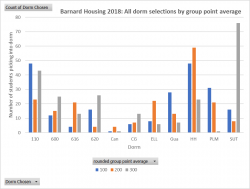
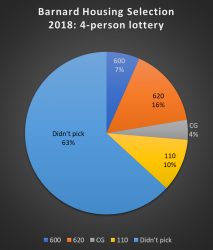
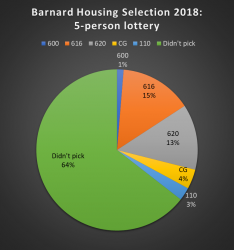
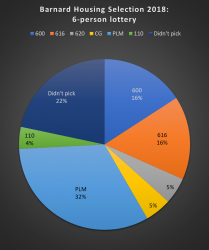
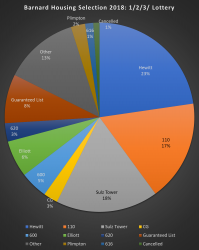
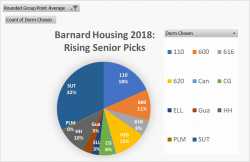
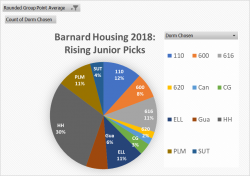
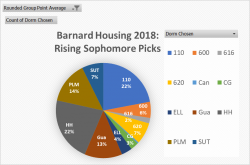

1 Comment
@:/ I think that the main problem with this year’s housing selection was that Sulz Tower (arguably the most popular dorm for rising seniors) was erroneously placed in the 123 lottery. Many seniors, driven by the compelling and yet fleeting vision of a single in Sulz Tower, took a risk, and chose to go 123. For some, the gamble paid off. For others, Sulz Tower was the sun to their Icarus, an unachievable and yet tantalizing goal. The Barnard housing lottery really is just en extended metaphor for the folly of man.